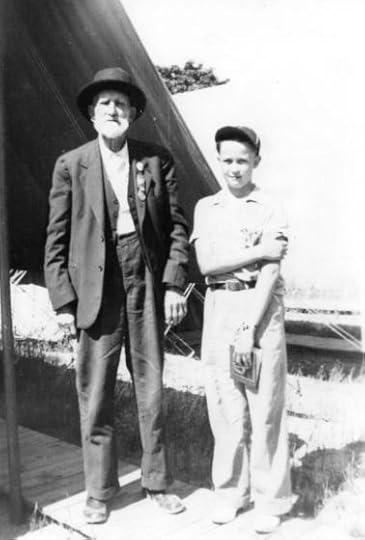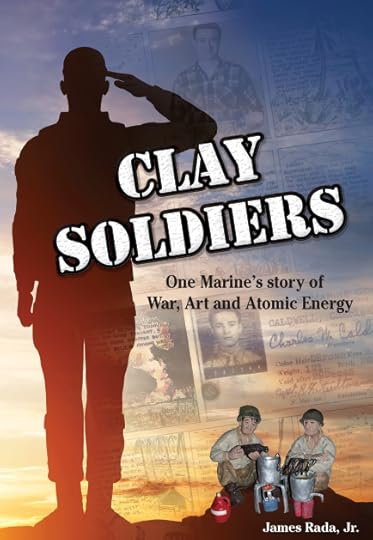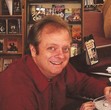The Last Reunion (part 2)
Note: As the publication of my new book, Clay Soldiers: One Marine’s Story of War, Art, & Atomic Energy draws closer, I thought that I would give you a preview of the book by publishing the first chapter over the next few weeks. The story is a biography of Chuck Caldwell, a WWII Marine who fought at Tarawa and Guadalcanal. He also worked in Nevada with the above-ground atomic bomb tests, attended the 75th, 100th, 125th and 150th anniversaries of the Battle of Gettysburg, and is a sculptor of miniature figures that are highly sought after. If you are interested in pre-ordering a copy of the book at a 25% discount off the cover price and free shipping in the U.S., contact me at jimrada@yahoo.com. As always, let me know what you think.

Chuck Caldwell at age 14, posing for a picture with Stephen Howe, a Confederate Civil War veteran, at the 75th reunion of the Battle of Gettysburg in 1938.
When the Caldwells finished their vacation in Gettysburg, they drove further east through York, Pennsylvania, which had served as the national capital in 1777 when the British drove the politicians from Philadelphia, and then through the heart of Amish country in Lancaster County. They finally stopped at Valley Forge. Oddly enough, the Revolutionary War site where Gen. George Washington’s Continental Army had encamped for the winter and suffered through starvation, disease, and malnutrition brought back memories of Chuck’s paper route in Orrville.
Chuck delivered the Courier-Crescent, Orrville’s daily newspaper, tossing papers to front stoops as he pedaled his bicycle through his hometown. On one section of his route, though, he had to dismount his bike and hike up a steep hill past the Crown Hill Cemetery at the intersection of Crown Hill Road and West High Street.
“On winter days, I was always imagining myself at Valley Forge, climbing up this hill in the deep snow and then having the person I was going to see not pay me for the week,” Chuck recalled.
He enjoyed the visit to Valley Forge, but it was the Civil War and the Battle of Gettysburg that stuck in his memory. Part of the reason for his interest in history, and in particular, the Civil War, was that his great-grandfather had fought in the war.
Private Isaac Caldwell had served in the First Tennessee Volunteers as part of Archer’s Brigade. A Union cavalry officers is believed to have fired the first shot in the Battle of Gettysburg at 7:30 a.m. on July 1, 1863. When the Confederate Army was still three miles west of Gettysburg. The Confederate Army halted and sent out skirmishers. Confederate General James Archer’s brigade encountered little resistance at first. Union infantry flanked Archer and caught him by surprise. Archer started a retreat through the woods and across Willoughby Run. Archer and 300 of his men were surrounded and captured. Private Caldwell’s company had marched near the front of the Confederate Army as it approached Gettysburg. Isaac was also one of the early casualties in the battle when he was wounded at Willoughby Run. He had survived the battle and the war, though, unlike thousands of other men.
In the 1930s, those whom the Civil War had not taken were slowly being picked off by time. Isaac Caldwell had died in 1885 and by 1938, only an estimated 8,000 Civil War veterans were still alive out of the more than 3.2 million men who had served in the armed forces. Chuck wished that he could have met all of them. He certainly gave it his best effort, but there was only so much that a fourteen-year old could do.
His father, George, who was the pastor at the Orrville Presbyterian Church, often spoke at other churches or meetings of pastors that were held outside of Orrville. Whenever he did, George would pour through the local newspapers and ask about whether there were any Civil War veterans living in the towns he visited. If there were, George would call them and make an appointment to stop by and get a picture, autograph, and some biographical information about them. Then he would give Chuck the mementos when he returned home.
Family members who knew of Chuck’s interest would save stories about Civil War veterans that popped up in their hometown newspapers from time to time. They would clip them carefully and mail them off to Chuck. He would open the envelopes like they were Christmas presents and read the stories looking for new information and names. Then he would paste the clippings into a scrapbook.
Chuck would often write to the veterans whose addresses he could find. He would pepper them with questions about their service in the Civil War, the battles they had fought, the hardships they had endured, and the training they had received. A good number of the veterans wrote him back. Chuck corresponded with some of them right up until they died.

Author interview with Chuck Caldwell.
Author interview with Chuck Caldwell.
Diana Loski, “A World War II Veteran Remembers,” The Gettysburg Experience, July 2014, 25.
Tim Smith, “The First Day at Gettysburg: Then and Now,” Civil War Trust (http://www.civilwar.org/battlefields/gettysburg/gettysburg-2011/gettysburg-then-and-now.html?referrer=https://www.mypoints.com/) accessed October 16, 2015.
Diana Loski, “A World War II Veteran Remembers,” The Gettysburg Experience, July 2014, 25.
Frank N. Britchner Collection scrapbook. Unsigned article. “Camp Aftermath.” The Frank N. Britchner Collection scrapbook is part of the Adams County (Pa.) Historical Society collection. It is part of a donation by a pharmacist who lived in Gettysburg at the time of the fiftieth reunion of the Battle of Gettysburg. The scrapbook is a collection of articles written during the 1913 and 1938 reunions. Many come from the Baltimore American, but many others have been clipped from the newspaper and so the origin is uncertain.
Author interview with Chuck Caldwell.





